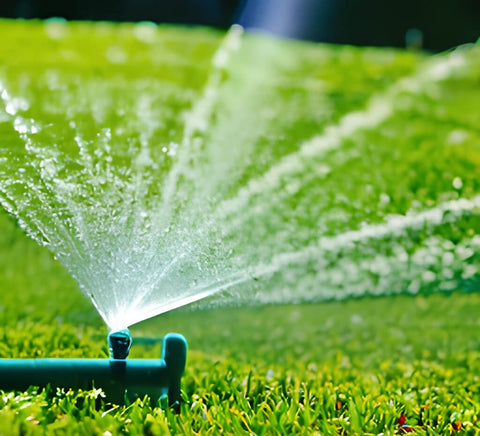A beautiful, healthy lawn is the envy of every neighborhood. But let's face it: most of us aren't lawn care experts, and who has the time for constant upkeep? Luckily, a few simple steps can transform your yard into a green oasis without sacrificing all your free time.
Mow Regularly and at the Right Height

One of the most important steps in maintaining a beautiful lawn is regular mowing. Aim to mow your lawn once a week during the growing season, and adjust the height of your mower blades depending on the type of grass you have.
- For cool-season grasses such as Kentucky Bluegrass and Tall Fescue, maintain the blades at an approximate height of 3 to 3.5 inches.
- The optimal cutting height for warm-season grasses fluctuates. For instance, with Zoysia, adjust the blades at a level of 1 to 2 inches. Keep in mind that the precise height depends on the type of grass.
Mowing turf at the proper height is vital to lawn health, but ideal height varies based on grass type, time of year, and growing conditions.
Source: BioAdvanced
Cutting the grass too short may cause undue stress and leave it prone to infection and infestation. An overly high mowing height can cause a buildup of thatch and a less appealing lawn.
You also need to alternate directions when mowing the lawn. Constant mowing in one direction can cause uneven grass growth. This can give it a spotty appearance. By varying the direction of mowing, you will induce upright growth in the grass. It produces a more consistent look.
Water Deep, Not Daily

Forget the light daily sprinkle! Deep, infrequent watering is the secret to a healthy lawn.
- Aim for 1-1.5 inches of water per week, divided into one or two sessions.
- Water in the early morning or evening to minimize evaporation.
The benefits: Deep watering encourages roots to grow deeper, making your lawn more drought-tolerant and disease-resistant.
How often you need to water your lawn depends on where you live and the kind of soil you have. Knowing your grass type and soil can help you save water and ensure that your grass is getting what it needs.
Source: bioadvanced
Watering Your Lawn – Know Your Soil
| Sandy Soil | Water soaks in quickly (like pouring water through sand). Water deeply, but less often. |
| Loamy Soil | Holds water well, drains moderately. Water moderately, a few times a week. |
| Clay Soil | Water soaks in slowly (like pouring water on a plate). Water less often, but make it a good soak when you do. |
|
Additional Tips: Observe your lawn |
See how quickly water soaks in after watering or rain. This will give you a clue about your soil type. |
|
Get a soil test |
This is the most accurate way to know your soil type and its specific needs. Your local Cooperative Extension Service can help with soil testing. |
|
Adjust your watering |
Water based on your soil type and the weather conditions. |
Fertilize Smartly
Fertilizer gives your grass the nutrients it needs to thrive. Choose a fertilizer formulated for your grass type and the season. Follow package instructions carefully to avoid over- or under-fertilizing.
- Ideal Timing: Fertilize in spring and fall when grass is actively growing.
- Skip Summer: Fertilizing during hot weather can scorch your lawn.
- Water After Fertilizing: Help the nutrients reach the roots, but avoid overwatering.
Fight Weeds and Pests Naturally (or With a Little Help)
Weeds and pests are a lawn's worst enemies. Here's how to keep them at bay:
- Prevention: Use pre-emergent herbicides to stop weed seeds before they sprout.
Pre-emergent is a fantastic product that has the potential to make your lawn look great in no time. Source: Covington Naturals
- Existing Weeds: Spot-treat with post-emergent herbicides or pull them by hand.
- Pests: Encourage beneficial insects, or use organic pesticides if necessary.
- Regular Inspection: Catch problems early before they take over. Routinely examine your lawn for evidence of weeds and pests to promptly identify and treat any problems.
Aerate and Overseed for a Thick, Healthy Lawn

Over time, soil compacts, making it difficult for water, air, and nutrients to reach the roots. Aeration and overseeding are the solutions:
- Aeration: Create small holes in the soil to improve drainage and access. Aeration can be done with a specialized tool, such as an aerator, a pitchfork, or a lawn mower aerator attachment.
- Overseeding: Spread grass seed to fill in bare patches and thicken the lawn.
Consider aerating and overseeding once a year or every other year, depending on your lawn's condition.
With regular aeration and overseeding, your lawn will withstand drought, disease, and other stresses and look lush all season long.
Your Dream Lawn Awaits
With these simple tips, you can achieve a beautiful lawn without spending hours on maintenance. Remember, a little effort goes a long way. So get out there, enjoy your yard, and let your lawn be the envy of the neighborhood!
Share Your Tips!
How do you keep your lawn looking its best? We'd love to hear your tips and tricks in the comments below!

